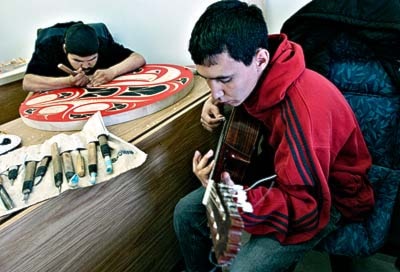Amid the odours of fresh paint and sawdust, wooden creations have already begun taking shape at the newest location of the Sundog retreat carving program.
Founded in 2004 by Andrew and Heather Finton, the Service-Canada funded program provides carving and other artistic training to about 30 emerging Yukon artists.
Program members divide their time between Sundog’s downtown location and an isolated retreat located off the Klondike Highway.
After four years of operation, the work of Sundog artists have started to gain local and national acclaim.
Governor General Michaelle Jean was presented with a mask created by Sundog carver William Callaghan during her Yukon visit in 2007.
Western Canadian premiers converging at an upcoming conference in Saskatchewan will each receive masks from the Sundog studio.
Even the Vancouver International Airport displays some Sundog originals.
The carvers have also been busy showcasing their work abroad.
A Sundog delegation visited the February Winterlude festival in Ottawa.
In March, Russia was visited by senior carver Calvin Morberg as part of a cultural exchange.
And business keeps booming.
“The demand is far greater than the output,” said carver Angel Hall.
“I’ve had to let go of a few commissions because I was so swamped with requests,” said carver Duran Henry.
Still, the Yukon market for First Nations art lies mainly untapped, said Heather.
Several Yukon patrons of First Nations art are still looking to sources from within BC, she said.
“It’s a lack of awareness; if only people knew the quality of goods coming from within these walls.”
With the program looking to ramp up its marketing efforts in the near future, Sundog is slowly becoming the “go-to” place for First Nations art, she said.
Already, interested buyers have visited the new location, perused Sundog’s existing collection and chatted with the carvers.
Standing before a half-completed tableau depicting the First Nations creation story of raven stealing the sun, Henry said that Sundog has provided a unique opportunity for him to study and recapture First Nations art traditions.
“I’ve learned about the history of the art form as well as the different stories that connect the culture together,” he said.
Sundog’s carvers in training have been mentored by an endless stream of accomplished artists, including Ken Anderson and Sean Hinton.
Many carvers have been drawn to the program because it offers a loose, unstructured learning environment, free from the restrictions of traditional schools.
“Myself included, there are many people here who can’t function in a standard educational program,” said Hall.
At Sundog, people learn from teachers who don’t have to be accountable to a board, and they aren’t ruled over by administrators who are out of touch with the student body, she said.
“Everybody here is on the ground floor,” Hall said.
“It’s more like an open environment for you to learn and be free and artistic,” said beginning carver Aubin Tuzlak.
In the background, senior carver Justin Smith took a brief break from his work on an upcoming tableau. Leaning across a table, he expertly strummed a song on an acoustic guitar.
Back in the beginner’s studio, carvers Tuzlak and Sara Villeseche sat surrounded by discarded wood chips.
Villeseche was guiding him through the nuances of carving rounded corners into a cedar mask.
Only two weeks into the program, Villeseche said that she had already sold a similar mask for $70 to a German couple.
Two weeks into the new location, Sundog has no plans to stop growing.
The new 4th Avenue location is only one step in a continuing expansion that will eventually see Sundog established as an accredited art institute coupled with a permanent art gallery.
